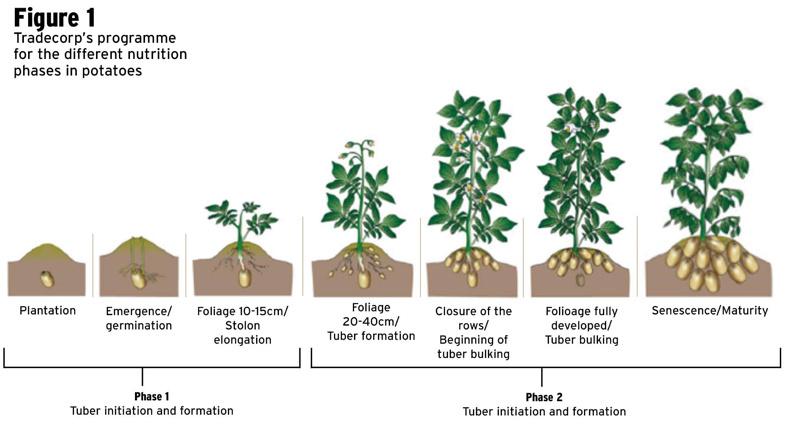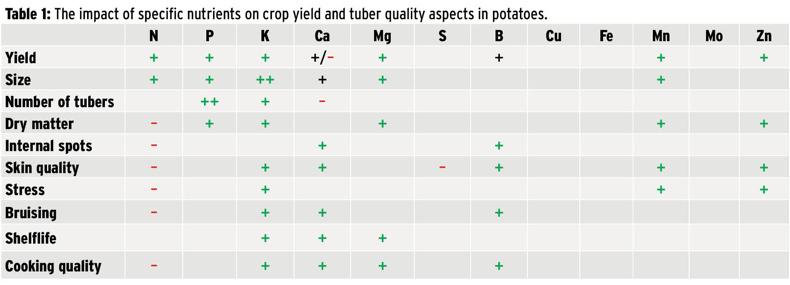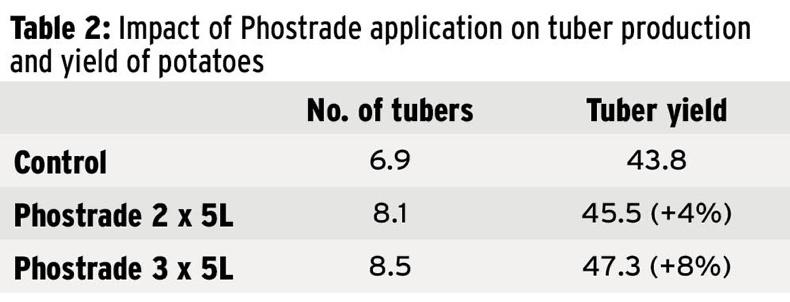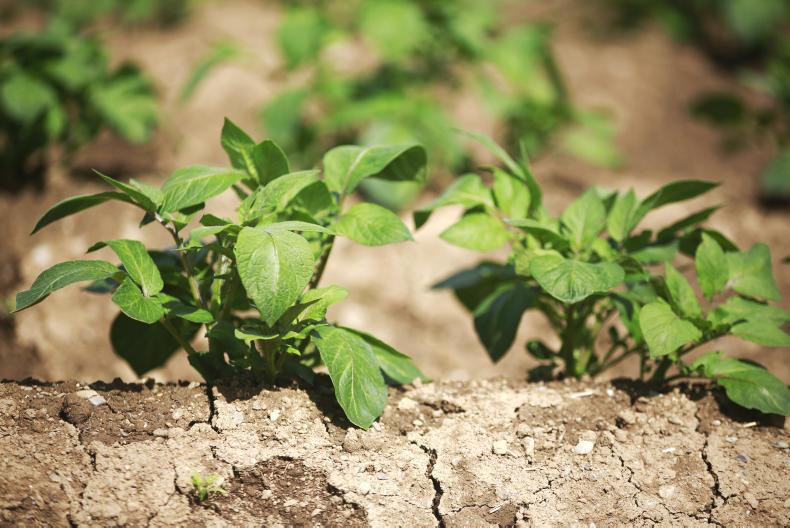On a trip to the Netherlands last September I had the opportunity to hear Vincent Claux from Tradecorp give a very interesting presentation on the fertilisation of potatoes. The approach he followed was nutrition to build yield potential and then deliver high saleable yield.
He described the nutrition of potatoes as targeting:
Phase 1 to build yield potential through tuber production during the tuber initiation stage, up to when plants meet across the row.Phase 2 happens after the haulms meet in the row and this targets the bulking up of the tubers and the degree to which that happens depends on the market and its specifications. From his company’s perspective, the use of Humifirst in the soil or Phostrade Mg-Zn or Trafos Mg-Mn on the foliage, helps provide the essential nutrition to ensure that tuber number is maximised in phase 1. Then the use of Final K and Magnitech to supply additional potash and magnesium can be very useful to manipulate tuber bulking to help meet market spec.
This is shown graphically in Figure 1 which aligns the physical stage of the crop with the nutrition phase.

A planned approach
Vincent explained that it is essential to have a strategy to do this. With Ireland’s current land rental situation in the potato sector, this could mean using foliar solutions on rented land and soil conditioners on owned land where there is likely to be additional longer term benefits.
“This is not a case of one size fits all,” Vincent emphasised. There is still a need to ensure that the rates and the products used be adjusted based on the crop’s potential and the ability of the land to produce and deliver this potential.
Potassium (K) is the driver of tuber size and yield in potatoes and magnesium (Mg) plays a part here also. For years there was a belief that every 1kg of N should be accompanied by 3-4kg of K. Nowadays the advice is 1kg of N to every 2.5-3.5kg of K. But the N:K relativity and the rates used are influenced by climate and in some instances this could require up to 5kg K/t of tuber yield. As time goes by it is more and more common to find K deficiency in potato crops, Vincent commented.
Understanding nutrition
In potato nutrition, nitrogen builds the factory, which is the foliage, and potash builds the bulk (the output). Potash also defines the quality of the potato harvest – all aspects of quality.
Magnesium is the most critical nutrient for the delivery of bulk because it adds up to 15% additional yield. It is especially important where light levels are lower during the bulking stage because Mg forces the production of more chlorophyll for photosynthesis and this makes more sugars for the bulking process.
The specific known impacts of the many different nutrients in potatoes is shown in Table 1.
One of the big challenge is to get better use of less nitrogen at the start of growth and to top up later if and where necessary. This is important because excessive nitrogen kills crop quality so it is essential to avoid applying too much. Nitrogen forces the production of new leaves and if there are too many new leaves produced at critical stages it means less of the total growth is going to make tubers. But the balance is still important.

Phosphate (P) is also very important. It is needed for the production of roots which means it is important for tuber numbers and also for tuber dry matter. The roots of potatoes are not very hardy or efficient and so it is important to have adequate nutrient accessible to them.
P could be regarded as the most complicated nutrient because of its importance and its cost. It is also not a very efficient nutrient in the soil but using humic acids in the seedbed helps P to work more efficiently.
Vincent said that the application of Humifirst in the soil helps potato root development and so increases the number of tubers produced. The product contains humic and fulvic acids which are active components of young, active and stable soil humus, where it exists.
Humifirst
The need for products like Humifirst arose initially from large horticultural operations in hot climates like Spain where continuous and intensive cultivation caused the clay to wash out of the soil. No clay means no delivery of nutrients. The application of humic and fulvic acids was found to considerably improve the soil and subsequent crop growth in those situations. Humifirst contains 12% humic acids plus 3% fulvic acids. Together these help to increase P availability and speed up early season growth, which is very important to generate yield potential. It was also found to help water holding capacity.
Put simply, Humifirst helps to increase root mass for nutrient uptake through improved root exploration of the soil by nutrient absorbing root hairs. By default, this implies a greater likelihood of exploring more of the total P in the soil. And as roots are pumping water and nutrients up to the growing plant, the improvement can also help recovery from drought.
Root biostimulants
Being able to stimulate root growth enables greater penetration of the soil mass by roots and, by default, provide access to more of the nutrient reserve. Research has shown that the use of Humifirst in the soil enhances the uptake of all nutrients, major and minor, in both potatoes and maize. However, root mass alone cannot be taken as the measure of response to any product. A growing root has a relatively short period of active nutrient uptake capability because this is mainly done by the root hairs closest to the growing tip of the root. Once a growing tip moves on, the root becomes a transport medium and a structural entity.
So stimulation of intensive root branching and new root production is where the main benefit lies. Nutrients play an important part in making this happen but the nutrients must be accessible to the root system for uptake. P availability is likely to be reduced where soil levels are low, when soil temperature is low, where pH is limiting and where nutrient mobility limits movement in the soil.
P is important in the early stages of growth because the potato has a lazy root system. So timing of application is important and a soil applied solution should be well suited to deliver the required response. Vincent stated that there is no benefit in split application where soils are colder in the spring.
In summary access to increased P tends to produce more roots which then help to scavenge more P from the soil reserves.
Trial results
Substantial research conducted by Tradecorp across a number of countries has shown that the use of Humifirst in the soil resulted in higher tuber numbers per plant and sometimes improved plant development.
A brief summary of these results indicates a tuber yield benefit of 19%, an increase in tuber numbers of 19% and a 19% increase in the uptake of N and P into the plant.
It is important to realise that the ability of the product to deliver benefit will always be site dependent. While the above numbers are average values, Vincent said that the average response on sandy soils was 6% every year but he indicated that overall yield levels were lower on these trial sites, possibly due to other yield constraints.
Foliar treatments
Where there is little incentive to improve soil conditions on rented land, foliar products are recommended to enhance the supply of P in particular to the plant to enhance rooting. The Tradecorp products recommended for this purpose are Phostrade MgZn or Trafos MgMn. Both products can be described as a PK foliar starter, each contains some Mg plus one other trace element. Rented land is frequently low in general fertility with limited nutrient availability, even where high amounts are applied to the seedbed. For this reason foliar applied P (and K) can help with early season rooting and tuber development during key growth periods.
It is well accepted that the availability of P, even applied P, to plant roots is lower in low P soils. Vincent suggested that utilisation of applied P by the growing crop could be as low as 15% in such situations. He also stated that P is much less available at lower soil temperatures and indicated that only 25% of soil P is available at 13°C compared to 100% at 21°C. And the fact that P reacts with calcium when pH is above 6.2 also makes it less available from the soil reserve.
Vincent suggested that foliar applied P can be up to 20 times more efficient than soil application. This can stand to reason for the relatively small quantities that are applied via these foliar treatments but they will need to be applied on a number of occasions to help deliver the benefits. An example of this can be seen in the results from a 2015 trial show in Table 2.

Trafos Mg-Mn is an equivalent foliar treatment to enhance P and K, as well as Mg and Mn availability to the plant to help drive early season yield building. The main difference is said to be that it is a different formation but capable of doing the same job.
There has been a lot of trial work done on the use of Trafos in Ireland by Precision Nutrition. These trials with a number of growers and locations showed higher tuber numbers and higher tuber yield from a range of application timings using rates from 3-4 l/ha. The marketable yield benefit varied from 3% to 13%.
Management is very important to help prevent abortion of tuber sites, Vincent emphasised. He agreed that it is very difficult to produce or to keep an optimum tuber number in a crop. In this regard he indicated that P may be helping to maintain or hold tuber number on a plant more so than increasing it to begin with. This comment emphasises the potential benefit of multiple applications on the crop.
In brief
Potato nutrition should focus on the yield building phase and then the tuber fill stage.Magnesium is said to be particularly important in regions that have low light intensity.Foliar application might best be used to target yield improvement on low fertility rented land.Actions to stimulate root growth can bring many associated benefits.
On a trip to the Netherlands last September I had the opportunity to hear Vincent Claux from Tradecorp give a very interesting presentation on the fertilisation of potatoes. The approach he followed was nutrition to build yield potential and then deliver high saleable yield.
He described the nutrition of potatoes as targeting:
Phase 1 to build yield potential through tuber production during the tuber initiation stage, up to when plants meet across the row.Phase 2 happens after the haulms meet in the row and this targets the bulking up of the tubers and the degree to which that happens depends on the market and its specifications. From his company’s perspective, the use of Humifirst in the soil or Phostrade Mg-Zn or Trafos Mg-Mn on the foliage, helps provide the essential nutrition to ensure that tuber number is maximised in phase 1. Then the use of Final K and Magnitech to supply additional potash and magnesium can be very useful to manipulate tuber bulking to help meet market spec.
This is shown graphically in Figure 1 which aligns the physical stage of the crop with the nutrition phase.

A planned approach
Vincent explained that it is essential to have a strategy to do this. With Ireland’s current land rental situation in the potato sector, this could mean using foliar solutions on rented land and soil conditioners on owned land where there is likely to be additional longer term benefits.
“This is not a case of one size fits all,” Vincent emphasised. There is still a need to ensure that the rates and the products used be adjusted based on the crop’s potential and the ability of the land to produce and deliver this potential.
Potassium (K) is the driver of tuber size and yield in potatoes and magnesium (Mg) plays a part here also. For years there was a belief that every 1kg of N should be accompanied by 3-4kg of K. Nowadays the advice is 1kg of N to every 2.5-3.5kg of K. But the N:K relativity and the rates used are influenced by climate and in some instances this could require up to 5kg K/t of tuber yield. As time goes by it is more and more common to find K deficiency in potato crops, Vincent commented.
Understanding nutrition
In potato nutrition, nitrogen builds the factory, which is the foliage, and potash builds the bulk (the output). Potash also defines the quality of the potato harvest – all aspects of quality.
Magnesium is the most critical nutrient for the delivery of bulk because it adds up to 15% additional yield. It is especially important where light levels are lower during the bulking stage because Mg forces the production of more chlorophyll for photosynthesis and this makes more sugars for the bulking process.
The specific known impacts of the many different nutrients in potatoes is shown in Table 1.
One of the big challenge is to get better use of less nitrogen at the start of growth and to top up later if and where necessary. This is important because excessive nitrogen kills crop quality so it is essential to avoid applying too much. Nitrogen forces the production of new leaves and if there are too many new leaves produced at critical stages it means less of the total growth is going to make tubers. But the balance is still important.

Phosphate (P) is also very important. It is needed for the production of roots which means it is important for tuber numbers and also for tuber dry matter. The roots of potatoes are not very hardy or efficient and so it is important to have adequate nutrient accessible to them.
P could be regarded as the most complicated nutrient because of its importance and its cost. It is also not a very efficient nutrient in the soil but using humic acids in the seedbed helps P to work more efficiently.
Vincent said that the application of Humifirst in the soil helps potato root development and so increases the number of tubers produced. The product contains humic and fulvic acids which are active components of young, active and stable soil humus, where it exists.
Humifirst
The need for products like Humifirst arose initially from large horticultural operations in hot climates like Spain where continuous and intensive cultivation caused the clay to wash out of the soil. No clay means no delivery of nutrients. The application of humic and fulvic acids was found to considerably improve the soil and subsequent crop growth in those situations. Humifirst contains 12% humic acids plus 3% fulvic acids. Together these help to increase P availability and speed up early season growth, which is very important to generate yield potential. It was also found to help water holding capacity.
Put simply, Humifirst helps to increase root mass for nutrient uptake through improved root exploration of the soil by nutrient absorbing root hairs. By default, this implies a greater likelihood of exploring more of the total P in the soil. And as roots are pumping water and nutrients up to the growing plant, the improvement can also help recovery from drought.
Root biostimulants
Being able to stimulate root growth enables greater penetration of the soil mass by roots and, by default, provide access to more of the nutrient reserve. Research has shown that the use of Humifirst in the soil enhances the uptake of all nutrients, major and minor, in both potatoes and maize. However, root mass alone cannot be taken as the measure of response to any product. A growing root has a relatively short period of active nutrient uptake capability because this is mainly done by the root hairs closest to the growing tip of the root. Once a growing tip moves on, the root becomes a transport medium and a structural entity.
So stimulation of intensive root branching and new root production is where the main benefit lies. Nutrients play an important part in making this happen but the nutrients must be accessible to the root system for uptake. P availability is likely to be reduced where soil levels are low, when soil temperature is low, where pH is limiting and where nutrient mobility limits movement in the soil.
P is important in the early stages of growth because the potato has a lazy root system. So timing of application is important and a soil applied solution should be well suited to deliver the required response. Vincent stated that there is no benefit in split application where soils are colder in the spring.
In summary access to increased P tends to produce more roots which then help to scavenge more P from the soil reserves.
Trial results
Substantial research conducted by Tradecorp across a number of countries has shown that the use of Humifirst in the soil resulted in higher tuber numbers per plant and sometimes improved plant development.
A brief summary of these results indicates a tuber yield benefit of 19%, an increase in tuber numbers of 19% and a 19% increase in the uptake of N and P into the plant.
It is important to realise that the ability of the product to deliver benefit will always be site dependent. While the above numbers are average values, Vincent said that the average response on sandy soils was 6% every year but he indicated that overall yield levels were lower on these trial sites, possibly due to other yield constraints.
Foliar treatments
Where there is little incentive to improve soil conditions on rented land, foliar products are recommended to enhance the supply of P in particular to the plant to enhance rooting. The Tradecorp products recommended for this purpose are Phostrade MgZn or Trafos MgMn. Both products can be described as a PK foliar starter, each contains some Mg plus one other trace element. Rented land is frequently low in general fertility with limited nutrient availability, even where high amounts are applied to the seedbed. For this reason foliar applied P (and K) can help with early season rooting and tuber development during key growth periods.
It is well accepted that the availability of P, even applied P, to plant roots is lower in low P soils. Vincent suggested that utilisation of applied P by the growing crop could be as low as 15% in such situations. He also stated that P is much less available at lower soil temperatures and indicated that only 25% of soil P is available at 13°C compared to 100% at 21°C. And the fact that P reacts with calcium when pH is above 6.2 also makes it less available from the soil reserve.
Vincent suggested that foliar applied P can be up to 20 times more efficient than soil application. This can stand to reason for the relatively small quantities that are applied via these foliar treatments but they will need to be applied on a number of occasions to help deliver the benefits. An example of this can be seen in the results from a 2015 trial show in Table 2.

Trafos Mg-Mn is an equivalent foliar treatment to enhance P and K, as well as Mg and Mn availability to the plant to help drive early season yield building. The main difference is said to be that it is a different formation but capable of doing the same job.
There has been a lot of trial work done on the use of Trafos in Ireland by Precision Nutrition. These trials with a number of growers and locations showed higher tuber numbers and higher tuber yield from a range of application timings using rates from 3-4 l/ha. The marketable yield benefit varied from 3% to 13%.
Management is very important to help prevent abortion of tuber sites, Vincent emphasised. He agreed that it is very difficult to produce or to keep an optimum tuber number in a crop. In this regard he indicated that P may be helping to maintain or hold tuber number on a plant more so than increasing it to begin with. This comment emphasises the potential benefit of multiple applications on the crop.
In brief
Potato nutrition should focus on the yield building phase and then the tuber fill stage.Magnesium is said to be particularly important in regions that have low light intensity.Foliar application might best be used to target yield improvement on low fertility rented land.Actions to stimulate root growth can bring many associated benefits. 








 This is a subscriber-only article
This is a subscriber-only article












SHARING OPTIONS: